Introduction
Hanuman Jayanti is a sacred festival celebrated by millions of devotees across India and the world to commemorate the birth of Lord Hanuman—the embodiment of unwavering devotion, strength, humility, and divine service. On this auspicious day, devotees recite and reflect on the Sundarkand—one of the most revered chapters of the Ramayan—to honor Hanuman’s immense courage, intellect, and bhakti (devotion) towards Lord Ram.
Sundarkand is not just a poetic marvel composed by Sage Valmiki in the Ramayan and later by Tulsidas in Ramcharitmanas—it is a spiritual tool to awaken divine virtues within us. It is considered the heart of the Ramayan, as it glorifies the superhuman deeds of Hanuman and reinforces the power of devotion over all obstacles.
Let us delve into the sublime significance of Sundarkand and the incredible leelas (divine acts) of Hanuman that continue to inspire spiritual seekers on the path of devotion and dharma.
What is Sundarkand?
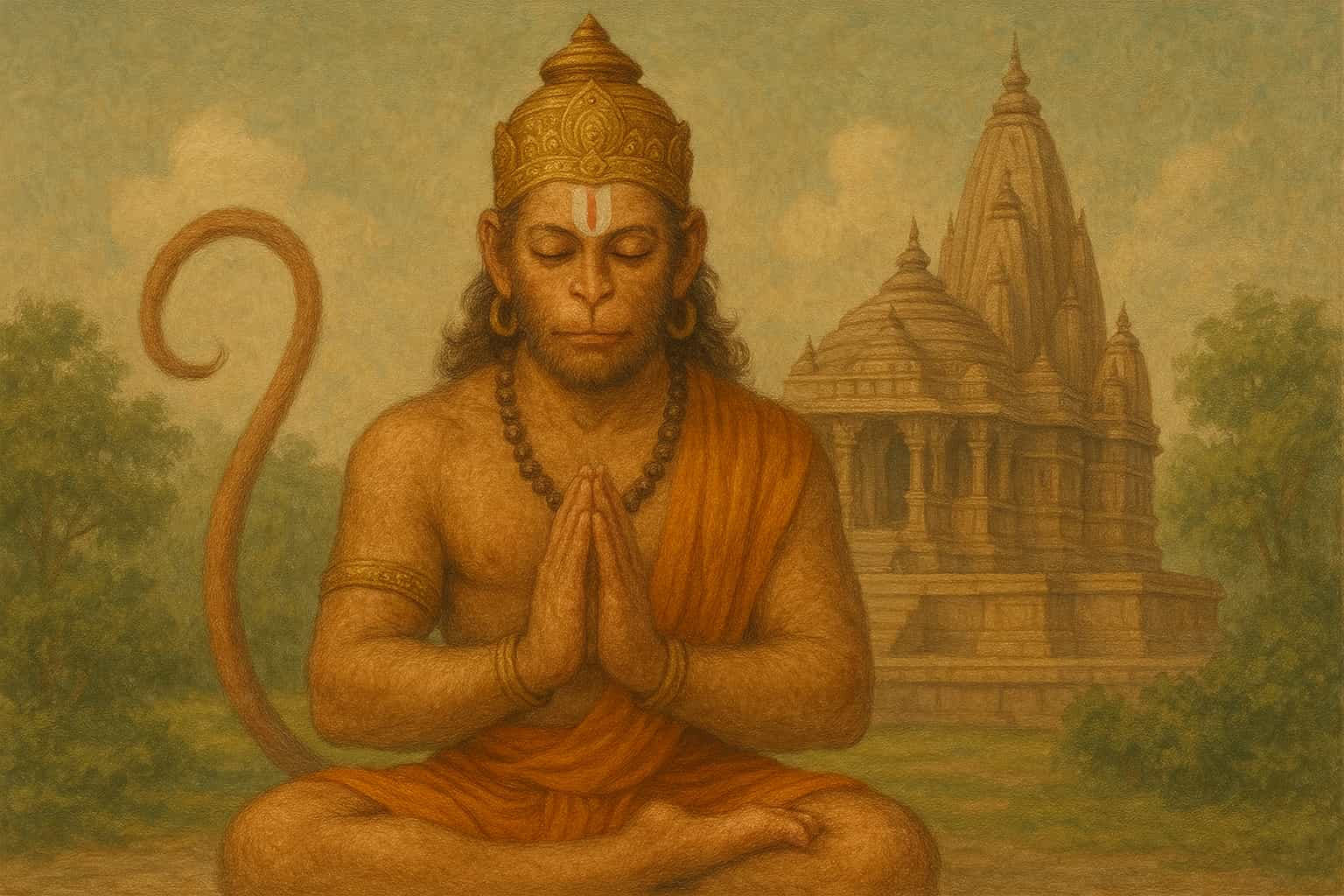
Sundarkand is the fifth book in the epic Ramayan, and the only kanda (section) that is named after an adjective—"Sundar", meaning beautiful. This beauty is not merely external but lies in the virtues and deeper spiritual meanings woven throughout this section.
While other kandas are named after events or places (like Ayodhya Kanda or Lanka Kanda), Sundarkand is called "beautiful" because:
- Hanuman’s character shines with divine brilliance.
- The mission of Lord Ram gains momentum as Hanuman finds Sita.
- The victory of good over evil begins to unfold.
- Bhakti (devotion) reaches its pinnacle in Hanuman's surrender.
Context of Sundarkand
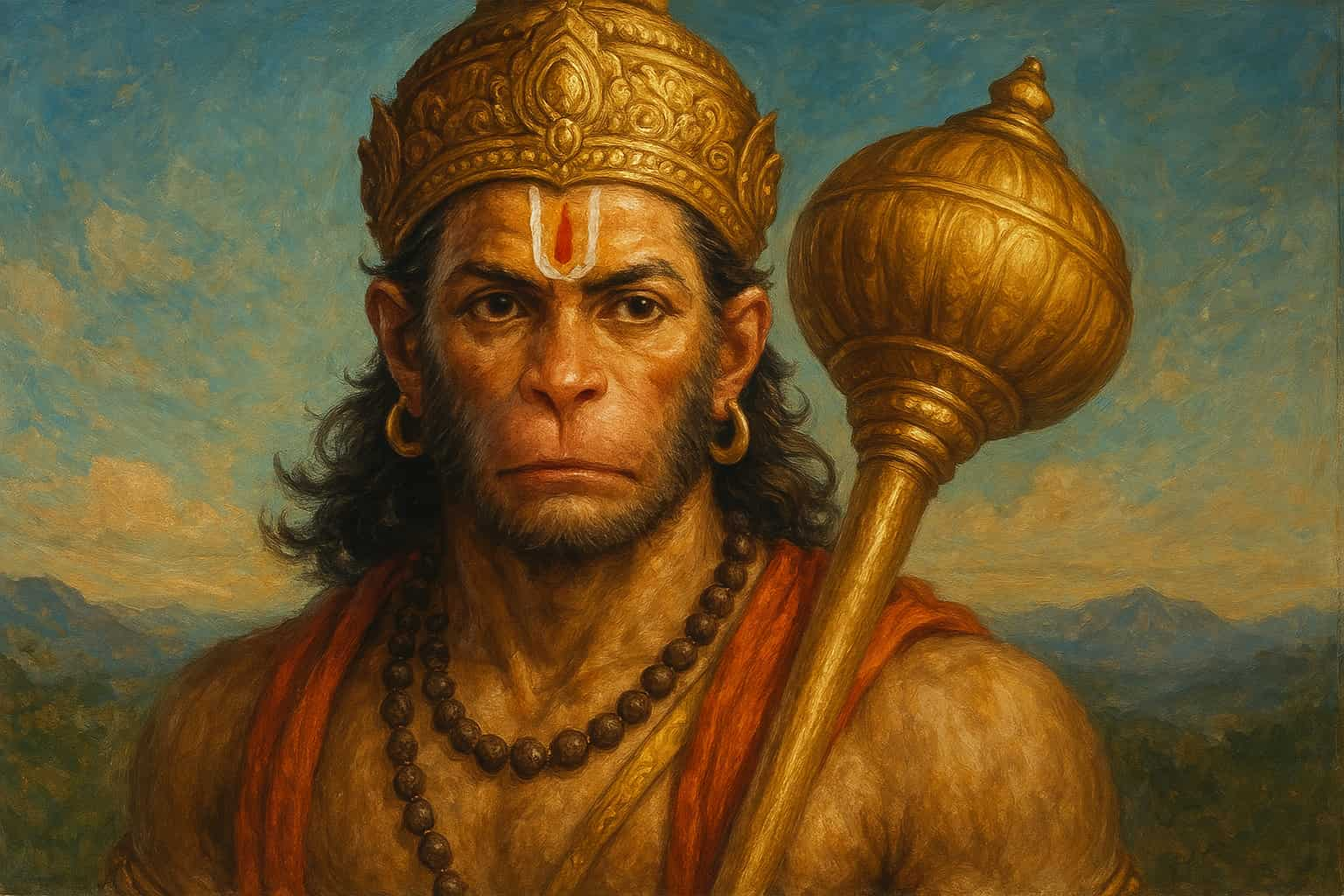
The Sundarkand begins after Sita is abducted by Ravan and held captive in the Ashoka Vatika in Lanka. Lord Ram is grief-stricken and seeks her whereabouts. Hanuman, as the most capable and devoted servant of Ram, is chosen to leap across the ocean and find her. What follows is a series of miraculous events—each showcasing Hanuman’s strength, intelligence, and unshakable devotion.
The Key Leelas of Hanuman in Sundarkand
1. Hanuman's Colossal Leap Across the Ocean – The Leela of Devotion-Driven Courage

When Jambavan reminds Hanuman of his forgotten powers, a surge of divine energy flows through him. This is a pivotal moment. Hanuman expands to a gigantic form, standing on Mount Mahendra, ready to cross the 100-yojana ocean to reach Lanka in search of Mother Sita. With absolute focus, he chants Lord Ram’s name and takes a mighty leap that splits the mountain and stuns the gods, sages, and celestials watching from above.
As Hanuman soars, he is not powered by mere physical strength but by unshakable bhakti (devotion) and selfless service. His focus is solely on Ram’s mission—no desire for personal glory, no attachment to outcomes. The ocean, vast and turbulent, represents life's trials, fears, and uncertainties. Yet, Hanuman, empowered by remembrance of his divine potential and Lord Ram’s grace, flies across it undeterred.
Life Lesson – Discovering Inner Potential through Devotion:
Swami Mukundananda ji often emphasizes that we are divine souls with infinite potential, but our self-limiting beliefs shackle us. Like Hanuman, we forget our inner power until awakened by divine knowledge or the guru’s reminder. When we surrender to a higher purpose, invoking the Lord’s name, and act with selfless determination, obstacles lose their strength. True courage arises not from ego, but from knowing we are instruments of God, guided and protected by His grace.
2. The Encounter with Surasa – The Leela of Divine Diplomacy and Humility

Midway across the ocean, Hanuman is stopped by Surasa, the mother of serpents, who blocks his path and insists on swallowing him. She has a boon that any being traveling across the ocean must pass through her mouth. Hanuman, instead of responding with force or frustration, approaches her challenge with intelligence. He begins enlarging his body, and Surasa matches him size for size. Then, in a sudden move, Hanuman shrinks himself to the size of a thumb, enters her mouth, exits immediately, and fulfills her condition without conflict.
Surasa, pleased by Hanuman’s cleverness and respectful demeanor, reveals her true form and blesses him. This encounter reflects Hanuman’s incredible emotional intelligence—he balances firmness with humility, strength with surrender, and wit with grace.
Life Lesson – Responding Wisely to Challenges:
Swami Mukundananda ji teaches us that not all difficulties in life are meant to break us—many are divine tests to sharpen our intellect and deepen our humility. When faced with confrontation or ego clashes, brute force or aggression is not always the answer. Hanuman’s behavior teaches that diplomacy, respect, and presence of mind often yield better outcomes. The spiritual seeker must be like water—adaptable, soft, yet powerful enough to cut through mountains over time.
3. The Slaying of Simhika – The Leela of Conquering the Shadow of Doubt

Further into his journey, Hanuman encounters the demoness Simhika, who possesses a sinister power: she can seize a being’s shadow, pulling them down from flight. As Hanuman begins to lose momentum, he realizes that it is Simhika’s dark magic. Without hesitation, he dives downward, enters her gaping mouth, and tears her apart from within, emerging victorious and continuing his journey unhindered.
Simhika represents the inner doubts, fears, and attachments that pull us down when we’re trying to rise spiritually. These shadows lurk in the unconscious mind—jealousy, insecurity, ego, or unprocessed trauma. Hanuman’s swift and fearless action signifies the seeker’s need to face inner demons head-on, destroy them through knowledge, resolve, and grace, and move forward toward the goal.
Life Lesson – Destroy the Inner Enemies:
As Swami Mukundananda ji beautifully explains, our biggest enemies are within—doubts, fears, and attachments are what hinder spiritual growth, not the world outside. To reach the Lord, we must first become aware of what is pulling us back, then confront those shadows with courage. Hanuman didn’t run from Simhika; he dived into her and defeated her. Similarly, we must examine our own minds through self-reflection, satsang, and sadhana, and conquer what holds us back from divine union.
4. Entering Lanka in a Tiny Form – The Leela of Humility and Stealth in Service

Upon reaching the shores of Lanka, Hanuman does not storm the kingdom or show off his might. Instead, he shrinks to the size of a cat and moves stealthily through the city at night. He marvels at the grandeur and opulence of Ravan’s palace but remains unmoved. His mind is completely focused on finding Sita and fulfilling Lord Ram’s mission.
This leela illustrates Hanuman’s total absence of pride. Despite his tremendous power and having crossed the ocean in one leap, he remains humble. He recognizes that the mission is not about him—it is about serving Shree Ram and reuniting Him with Mother Sita . Even when caught and brought to Ravan’s court, Hanuman maintains his dignity and fearlessness, never compromising his devotion or succumbing to fear.
Life Lesson – Ego-less Action in Service:
Swami Mukundananda ji teaches that humility is the ornament of true greatness. Even the most accomplished person must bow to a higher purpose and act as a servant of the Lord, not as the doer. Hanuman shows us how to do great things without letting the ego inflate. When we shed pride and act with humility, our actions become pure, impactful, and blessed. Whether our seva is big or small, what matters is the bhav (intention) with which we serve.
5. Finding Sita and Delivering the Message of Hope – The Leela of Empathy and Encouragement
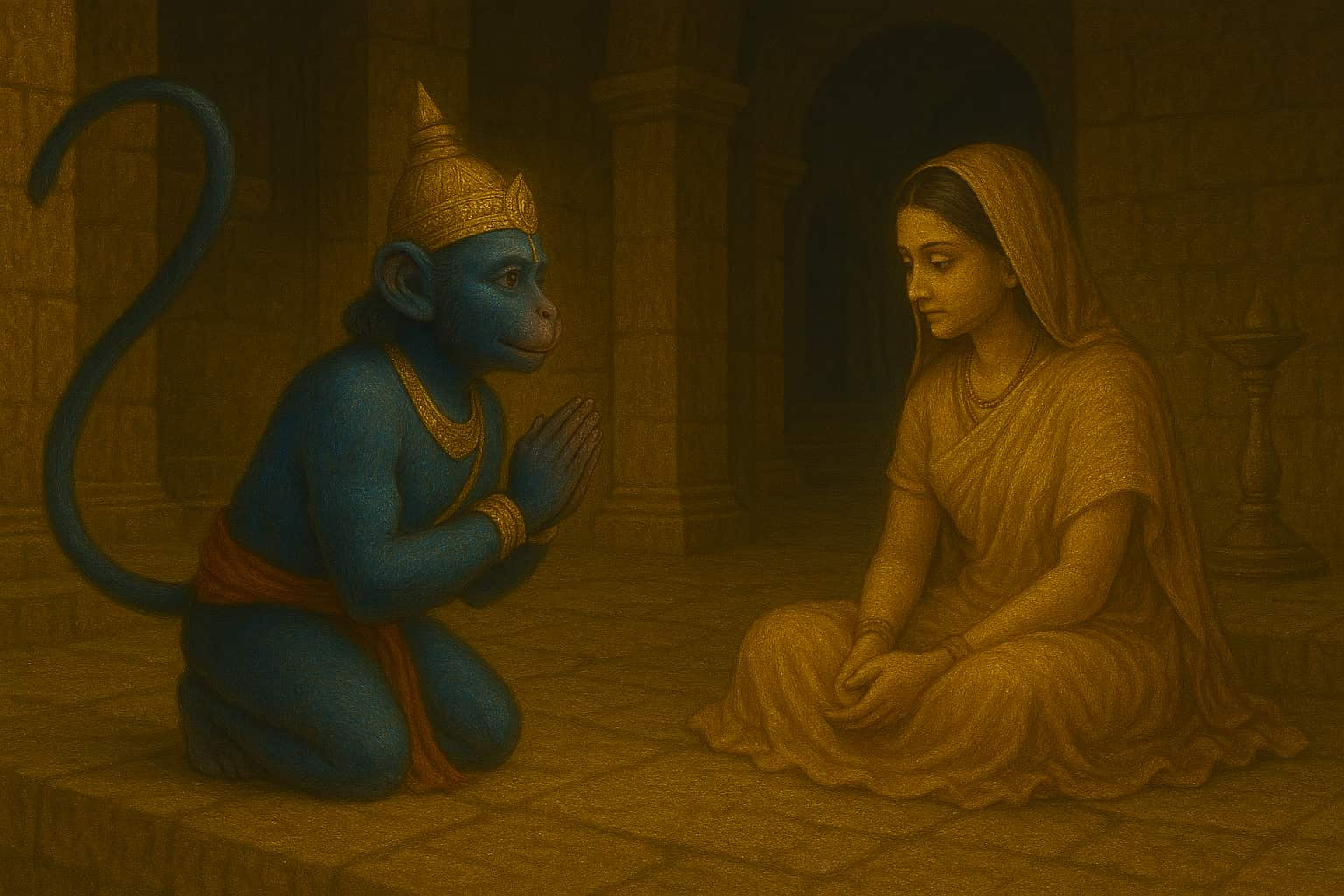
After searching tirelessly, Hanuman finds Sita in the Ashok Vatika, sorrowful and frail from months of separation. Hanuman’s approach here is filled with empathy, gentleness, and deep emotional sensitivity. He first wins her trust by softly chanting Ram’s name and reciting His story, ensuring her that he is a genuine messenger.
He presents Lord Ram’s ring, a powerful symbol of love and authenticity. Sita is filled with hope and strength again. Hanuman refuses to return without giving her this assurance and fulfilling his mission. He uplifts her spirits, assures her of Ram’s imminent arrival, and bows to her as the Divine Mother.
Life Lesson – Be a Messenger of Hope:
Swami Mukundananda ji often shares that the greatest seva is to uplift someone’s heart. In a world full of pain and separation from the Divine, we should become instruments of comfort, positivity, and divine remembrance. Hanuman could have returned with a report, but he stayed to nurture, protect, and emotionally empower Sita. Like him, we should cultivate empathy and service-oriented love, becoming ambassadors of God’s grace and compassion in people’s lives.
6. Burning Lanka – The Leela of Righteous Wrath and Divine Justice
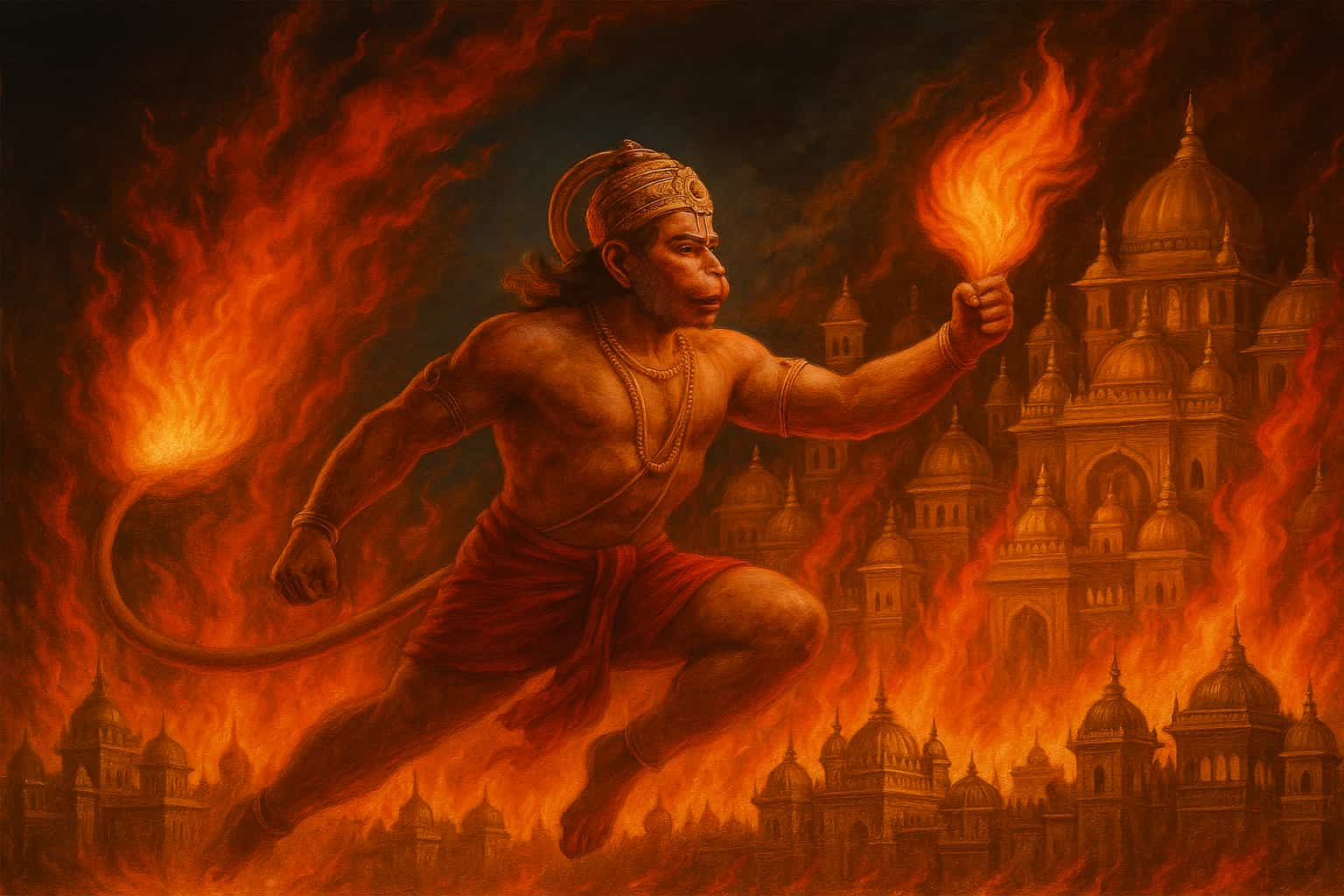
After delivering the message, Hanuman allows himself to be captured by Ravan’s soldiers, deliberately letting them bind him with ropes that cannot hold a divine being. In Ravan’s court, Hanuman speaks truth fearlessly and warns Ravan to return Sita. In response, Ravan orders his tail to be set on fire. But Hanuman, immune to fire by boon, escapes, grows in size, and sets Lanka ablaze with his fiery tail, symbolically purging the city of arrogance and adharma.
Despite being a devotee known for humility, Hanuman’s righteous anger is invoked to uphold dharma. He does not act out of revenge but from divine justice. His leela here teaches that when humility and kindness are mistaken for weakness, one must rise to defend righteousness without ego or hatred.
Life Lesson – Stand for Dharma with Inner Strength:
Swamiji reminds us that spirituality is not passivity. While we are peaceful by nature, there are moments when we must assert ourselves for truth, without personal attachment. Hanuman’s action was not born from vengeance but from the need to restore balance and awaken Ravan’s conscience. Similarly, in life, we must stand strong for what is right, using our power not for ego, but for divine justice, all while remaining internally detached and surrendered to God’s will.
7. The Triumphant Return – The Leela of Selfless Reporting and Zero Pride
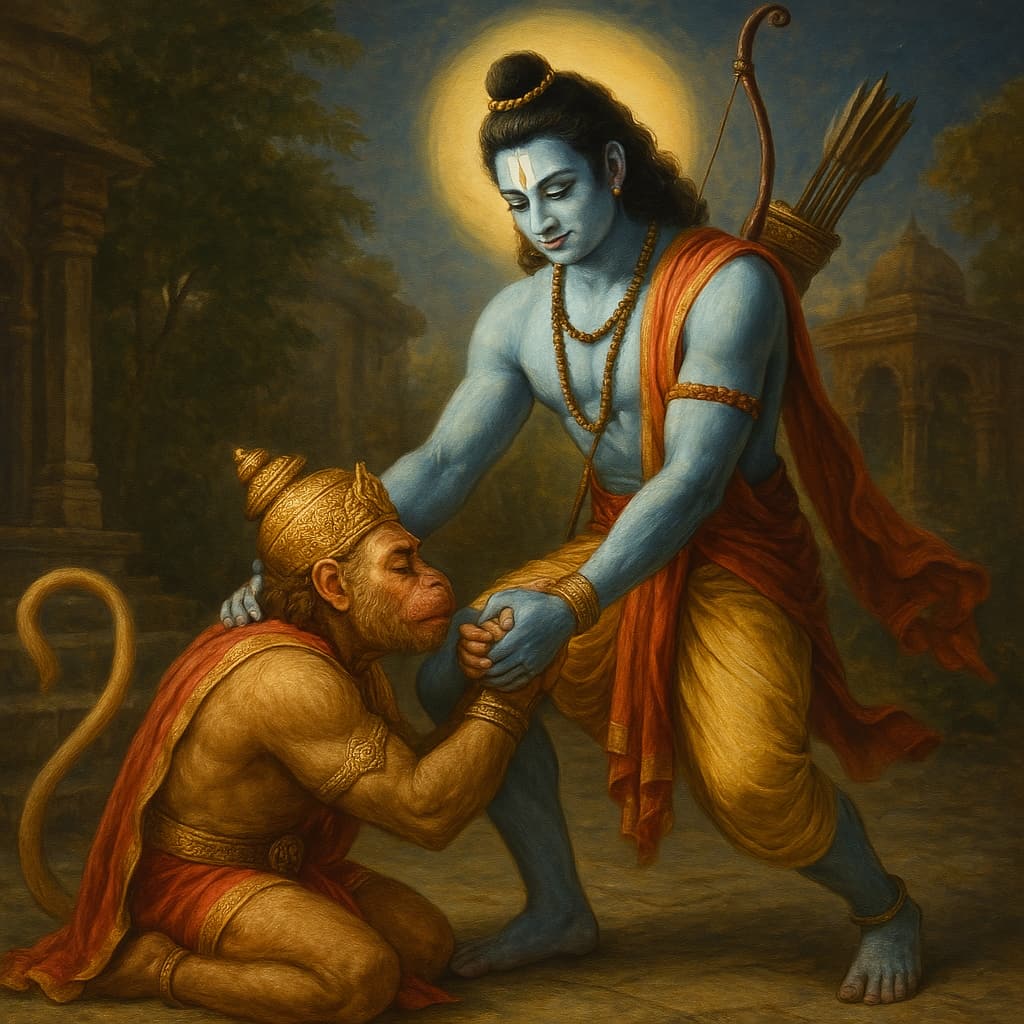
After completing all his tasks, Hanuman returns to Ram with a heart full of joy. He narrates everything with clarity and focus—not once boasting of his heroic deeds. Instead, he emphasizes Sita’s sorrow, her chastity, and her undying love for Ram. His only concern is Ram’s joy and Sita’s relief.
Hanuman never claims credit. He doesn’t seek rewards or recognition. His fulfillment lies in knowing he served his Lord. Even Ram is moved by his devotion and embraces him with tears of love and pride.
Life Lesson – Dedicate All Success to God:
Swami Mukundananda ji teaches that the fruit of all action should be offered to God. When we act with selflessness, free from ego and expectation, our work becomes sacred. Hanuman exemplifies Nishkam Karma Yoga—acting for the Lord without seeking fruits. His example shows us how to live in the world, achieve great things, yet remain unattached and deeply devoted, giving all credit to God’s grace.
The Glory of Sundarkand and the Path It Reveals
The Sundarkand of Ramayan, narrated by Tulsidas ji and adored by saints like Swami Mukundananda ji, is not just a poetic segment—it's a spiritual blueprint. Hanuman’s leelas illustrate every step of the seeker’s journey—awakening, faith, overcoming inner darkness, humility, fearlessness, empathy, divine strength, and ultimate surrender.
Through Hanuman’s character, we see a reflection of our own potential, reminding us that when we dedicate ourselves to a higher cause with unwavering faith, we too can become instruments of divine will.
The Significance of Sundarkand on Hanuman Jayanti
1. A Mirror to Hanuman’s Divine Character
On Hanuman Jayanti, reading the Sundarkand is one of the most cherished traditions. It reminds devotees of Hanuman's selflessness, strength, intelligence, and unshakable bhakti. His example sets the ideal for how to live a life of purpose and devotion.
2. A Path to Inner Strength
Each episode in Sundarkand reflects inner challenges we face—fear, doubt, ego, temptation—and how they can be overcome by surrendering to a higher will.
Devotees believe that chanting or listening to Sundarkand removes obstacles, grants peace, and strengthens willpower.
3. A Cure for Mental and Spiritual Suffering
It is widely held that regular recitation of Sundarkand:
- Calms the mind
- Relieves anxiety and depression
- Bestows protection from negative forces
- Fills life with optimism and spiritual clarity
This is especially powerful when done on Tuesdays, Saturdays, and of course, Hanuman Jayanti.
Why the Name "Sundarkand"?
Several spiritual reasons are given for naming this chapter “Sundarkand”:
- Sundar (beautiful) is Hanuman's soul, filled with devotion.
- Sundar is the dialogue between Hanuman and Sita, filled with divine love.
- Sundar is the message of Ram, which brings hope.
- Sundar is the journey of Hanuman, who represents the beauty of karma yoga (selfless action).
- Even Lanka becomes “Sundar”, as it hosts the beginning of Ravan’s end.
Hanuman – The Ideal Devotee
What makes Hanuman so beloved is not just his strength but his total surrender and humility.
- He never claimed any feat as his own.
- He never sought reward or praise.
- His only joy was in serving Ram.
When Ram asked Hanuman how he viewed himself, Hanuman said:
"When I think of myself as the body, I am your servant.
When I think of myself as a soul, I am your part.
But when I realize my true self, You and I are one."
This shows the three stages of spiritual evolution: Duality (Dasa), Devotion (Bhakta), and Unity (Advaita).
Conclusion: Eternal Lessons from Hanuman’s Leelas on Hanuman Jayanti
Sundarkand is not merely a chapter in the Ramayan—it is a sacred spiritual roadmap, a living, breathing sadhana that teaches us how to overcome adversity, conquer the mind, and rise to our highest potential. Each verse, each leela, each moment of Hanuman’s journey is infused with deep spiritual symbolism and eternal wisdom. It is a treasure trove of divine truths waiting to be unlocked by the sincere seeker.
On the auspicious occasion of Hanuman Jayanti, as we bow down to the greatest devotee of all time, let us not just worship Hanuman externally, but also strive to awaken the Hanuman within ourselves. Let us meditate upon his divine leelas that are rich with meaning and inspiration:
- His leap across the ocean symbolizes the boundless strength that faith can generate.
- His fearless confrontation with obstacles reveals the power of complete surrender to God.
- His razor-sharp focus on his goal shows us the path of single-pointed devotion.
- His humility even after achieving great feats teaches us how to serve with love, not ego.
These are not just stories—they are spiritual milestones we must emulate in our lives.
Let us invoke Hanuman’s blessings to:
- ✅ Face life’s toughest challenges with courage and resilience.
- ✅ Serve others with selflessness and dedication, expecting nothing in return.
- ✅ Cultivate a heart that loves God unconditionally, through joy and sorrow alike.
- ✅ Stay deeply humble, even when success and recognition come our way.
This Hanuman Jayanti, may Sundarkand become the song of your soul—the mantra that uplifts your spirit and reminds you that the divine lives within you. May Hanuman’s valor become your shield, his bhakti your guide, and his wisdom your strength.
Let every heartbeat echo with faith.
Let every breath whisper the name of Ram.
Let every action be filled with seva, humility, and courage.
Jai Bajrangbali! Jai Veer Hanuman! Jai SiyaRam!
Call to Action
Join the Radha Krishna Temple of Dallas for a spiritually uplifting Hanuman Jayanti celebration filled with devotion, inspiration, and divine energy.
🕉️ Immerse yourself in the powerful vibrations of Sundarkand Parayan
🎶 Experience soul-stirring bhajans and kirtans
🪔 Be inspired by devotional discourses and Hanuman leelas
🙏 Receive blessings through special Hanuman Abhishekam and Aarti
📅 Date: [April 12]
📍 Location: Radha Krishna Temple, Allen, TX
🔗 Details & RSVP: [https://www.radhakrishnatemple.net/hanuman-jayanti]
Let us come together to invoke the strength, devotion, and grace of Veer Hanuman. Bring your family and friends for an evening of bhakti, blessings, and bliss!
Jai Bajrangbali! Jai SiyaRam!
Frequently Asked Questions (FAQs) on Sundarkand
1. Why is Sundarkand considered the heart of the Ramayan?
Sundarkand is the only section named "Sundar" (beautiful), not for its poetic grace alone, but because it glorifies Hanuman’s divine virtues—his strength, intellect, and unshakable devotion to Lord Ram. It marks the turning point in the Ramayan where the hope of victory over evil begins to blossom through bhakti and selfless action.
2. What is the spiritual relevance of reciting Sundarkand on Hanuman Jayanti?
On Hanuman Jayanti, chanting Sundarkand invokes Hanuman’s blessings for courage, protection, and spiritual clarity. Each verse is said to remove inner obstacles, instill faith, and align the devotee with the values Hanuman represents—selfless service, humility, and fearless devotion.
3. How does Hanuman’s journey in Sundarkand relate to our spiritual path?
Hanuman’s leelas reflect a seeker’s inner transformation:
- His leap symbolizes overcoming fear through faith.
- The battle with Simhika represents conquering self-doubt.
- His humility in Lanka shows ego-less service.
Each episode is a metaphor for progressing on the spiritual journey with divine strength and surrender.
4. What are the key life lessons from Hanuman’s actions in Sundarkand?
Hanuman teaches us to:
- Act with humility, not ego.
- Face trials with courage and wisdom.
- Offer all success to the Divine.
- Balance strength with compassion.
- Stay unwavering in devotion, regardless of the challenges.
5. Why is Hanuman called the ideal devotee?
Hanuman’s greatness lies not just in his powers but in his utter humility and surrender. He never took credit for any of his heroic feats, always attributed them to Lord Ram, and saw himself as the Lord’s servant. His devotion transcends duality and becomes a path to spiritual unity—making him the perfect embodiment of bhakti yoga.


